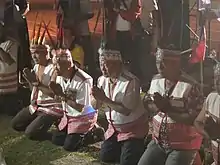Taokas people
Taokas (Chinese: 道卡斯族; pinyin: Dàokǎsī Zú) is one of a number of indigenous ethno-linguistic groups that inhabited the plains of western Taiwan. The Taokas were located in the areas around today's Hsinchu City/Hsinchu County, Miaoli County, and Taichung City region. Several Taokas groups have been historically linked to many revolts that plagued Taiwan during the Qing era (1683–1895). The Taokas were not always opposed to Han encroachment on their lands as several Taokas groups were involved in building the Ta-Chia Mazu Temple. Today, only a small number of people in the central city of Puli identify themselves as ethnic Taokas or even Taiwanese Aborigines.
Taokan, Taokas | |
|---|---|
 Taokas men on the annual ceremony Khantian. | |
| Regions with significant populations | |
| Hsinchu, Miaoli, and Nantou in Taiwan | |
| Languages | |
| Taokas, Taiwanese, Mandarin | |
| Religion | |
| Animism, Taoism, Buddhism, Christianity | |
| Related ethnic groups | |
| Babuza, Saisiyat |
| Taiwanese indigenous peoples |
|---|
 |
| Peoples |
|
Nationally Recognized Locally recognized Unrecognized |
| Related topics |
This article is issued from Wikipedia. The text is licensed under Creative Commons - Attribution - Sharealike. Additional terms may apply for the media files.